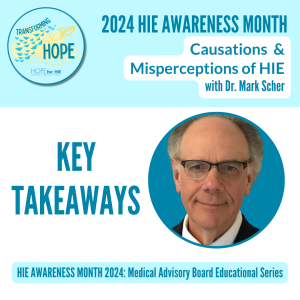
Navigating the complexities of HIE can often feel like wading through a thicket of uncertainties and questions. Families can spend a lot of time and resources to discern the root cause of the diagnosis, often amidst a tangle of information and misperceptions. It’s a journey that requires delving into the details, understanding the nuances, and working closely with medical teams to unravel the complexities of this diagnosis, and even then, families don’t always walk away with a clear answer.
Dr. Mark Scher, Professor of Pediatrics and Neurology at Case Western Reserve University School of Medicine and Former Chief of the Division of Pediatric Neurology Rainbow Babies and Children’s Hospital of the University Hospitals of Cleveland, met with Hope for HIE to explore the intricacies of HIE, shed light on the myriad factors that contribute to it, and discuss how families can navigate through the weeds of misinformation to gain a clearer understanding of their situation.
Missed the live stream Q&A? No worries. We took notes, and like any good partner, we are willing to share! Read our key takeaways below.

As Dr. Scher points out, being born is tough. It’s one of the most stressful events for both mom and baby. And when an unexpected traumatic or encephalopathic event occurs, there can be a lot of uncertainty clouding the cause of that event and the road moving forward.
This uncertainty is not exclusive to families; doctors and nurses grapple with it, too, and for a multitude of reasons: many babies appear sick or in distress immediately upon being born, simply because they just underwent a massive transition from womb to world. There are moments when medical teams have to wait until the smoke clears to collect information, determine the type of injury, and do their absolute best with the tools at hand to understand what happened and why.
The only way through this uncertainty is through data collection: APGAR scores, MRIs, EEGs, and clinical exams can all shed some light on the why behind HIE, but as our families know, they are not always conclusive, and there are so many confounding factors that could have led to its occurrence. So, while this may not be an option for every family, as some hospitals do not have the resources or access to such advanced testing, Dr. Scher encourages a thorough examination of the placenta, which he likens to a diary of that mom’s pregnancy: it carries a wealth of information about the health and development of both the baby and the mother. For example, it can reveal signs of infection, such as inflammation or the presence of specific pathogens, that were present in the baby but perhaps did not present in the mother. It can also show abnormalities in its size, shape, or structure, indicating issues with blood flow or oxygen transfer to the baby.
While a comprehensive evaluation of the placenta may not be the whole combination that unlocks the chest of answers, it can at least provide the first few digits. The NIH knows precisely this, which is why, in 2014, they launched a collaborative research initiative—The Human Placenta Project—that aims to advance our understanding of the placenta and its role in pregnancy, fetal development, long-term health outcomes for both mothers and babies, and prevention of potential issues, like those that can lead to HIE.

As Dr. Scher points out, being born is tough. It’s one of the most stressful events for both mom and baby. And when an unexpected traumatic or encephalopathic event occurs, there can be a lot of uncertainty clouding the cause of that event and the road moving forward.
This uncertainty is not exclusive to families; doctors and nurses grapple with it, too, and for a multitude of reasons: many babies appear sick or in distress immediately upon being born, simply because they just underwent a massive transition from womb to world. There are moments when medical teams have to wait until the smoke clears to collect information, determine the type of injury, and do their absolute best with the tools at hand to understand what happened and why.
The only way through this uncertainty is through data collection: APGAR scores, MRIs, EEGs, and clinical exams can all shed some light on the why behind HIE, but as our families know, they are not always conclusive, and there are so many confounding factors that could have led to its occurrence. So, while this may not be an option for every family, as some hospitals do not have the resources or access to such advanced testing, Dr. Scher encourages a thorough examination of the placenta, which he likens to a diary of that mom’s pregnancy: it carries a wealth of information about the health and development of both the baby and the mother. For example, it can reveal signs of infection, such as inflammation or the presence of specific pathogens, that were present in the baby but perhaps did not present in the mother. It can also show abnormalities in its size, shape, or structure, indicating issues with blood flow or oxygen transfer to the baby.
While a comprehensive evaluation of the placenta may not be the whole combination that unlocks the chest of answers, it can at least provide the first few digits. The NIH knows precisely this, which is why, in 2014, they launched a collaborative research initiative—The Human Placenta Project—that aims to advance our understanding of the placenta and its role in pregnancy, fetal development, long-term health outcomes for both mothers and babies, and prevention of potential issues, like those that can lead to HIE.

This is precisely why the aforementioned Human Placenta Project is so exciting—researchers hope to uncover new insights into pregnancy-related disorders and develop better diagnostic tools and treatments to improve maternal and fetal outcomes.
Dr. Scher also referenced important work by Dr. Katherine Limperopoulos, a scientist, a leading expert in fetal and neonatal brain development, and head of the Developing Brain Research Laboratory at Children’s National Hospital in Washington, D.C. Her and her team have been pioneering efforts to use fetal MRI to study the placenta and the developing brain as early as the second trimester of pregnancy. By examining the structure and function of the placenta and the fetal brain, they aim to identify early signs of developmental abnormalities and conditions, like placental insufficiency, abnormal placental implantation, and umbilical cord abnormalities, that could affect fetal brain health and development.
The ultimate goal is to find opportunities to intervene and potentially mitigate the risk of adverse outcomes in the early stages of pregnancy

As Dr. Scher explains, it’s very challenging to look at all the factors contributing to HIE to find its exact causation. We know some common causes — preeclampsia, cord entanglement, fetal-maternal hemorrhaging, placental abruption, labor and delivery issues, blood clotting… the list goes on and on.
But there are other factors to consider, especially in light of our recent pandemic. Covid has opened our eyes to many of these factors, including the ways various pathogens can hurt the placenta by a fetal inflammatory response, making the mother sick and compromising the delivery.
And then there’s stress, which isn’t just an inner, psychological phenomenon, as Dr. Scher explains. There’s a concept called toxic stressor interplay — “toxic” referring to prolonged exposure to stress without relief, and “interplay” referring to the interaction of internal and external stressors — that can have effects on pregnancy outcomes.
Toxic stressor interplay recognizes that physical, psychological, environmental, and socioeconomic stressors — to name a few– do not operate in isolation but often interact and compound each other’s effects. For example, a pregnant woman experiencing financial stress may also face psychological stress due to uncertainty about her and her baby’s future, leading to physiological changes that impact fetal development.
Since its effects can be far-reaching, when considering a newborn with a neurological problem like HIE, understanding the potential role of stressors is really important for understanding causation and for future family planning.

As an organization dedicated to advocacy and support, we know the importance of ensuring that our families have access to as much information as possible regarding the causes and outcomes of their child and any additional children they may plan to have in the future.
And while it may not change their child’s outcome, genetic testing can
provide valuable insights for future family planning and offer a deeper understanding of potential vulnerabilities that may have contributed to the baby’s risk at birth.
For instance, the HEAL study’s secondary analysis cohort revealed that approximately 5% of the cohort’s enrolled infants had genetic and congenital anomalies, which can mask as HIE. So, it comes as no surprise that many families are increasingly receiving referrals to genetics departments, and some are coming back with positive genetic markers.
It’s important to note that genetic testing methods are not perfect: these tests may not provide all the answers, but they can significantly reduce uncertainty for families, enabling them to make more informed decisions as they plan their future.

Honest and open dialogue between medical professionals and families is essential in navigating the complexities of HIE. It allows for shared-decision making, where both the patient-families and medical teams can work alongside one another to understand their child’s condition and treatment options.
But we live in a litigious society, where doctors’ fear of legal repercussions often looms large, and members of their risk departments can sit a little too comfortably on their shoulders. This, combined with misinformation perpetuated by untrustworthy sources, can further exacerbate this issue, leading to a breakdown in trust.
So, what’s the solution? Building proper communication techniques for hospital providers, combined with the proper health literacy and advocacy tools for parents, can help all parties overcome these communication barriers posed by medico-legal concerns.
Dr. Scher also mentions that doctors are human, like all of us. Mistakes can and do happen, and when those mistakes do contribute to a brain injury, accountability is important. But like all of us, doctors can’t predict the future, and there’s something to be said about the inherent uncertainty behind the many factors contributing to an HIE diagnosis.
Just as it’s their role to pursue knowledge and information in the face of that uncertainty, the parent’s job is to ask questions and raise concerns to their medical team when they arise.
Even so, the landscape is changing. Parents, equipped with increasing advocacy skills and knowledge, are becoming increasingly empowered participants in the shared decision-making process. This shift is fostering an environment where their voices are heard, their concerns are addressed, and their input is valued.

Hope for HIE’s Clinical Hub: It brings together the best resources we know of, reviewed by our Medical Advisory Board, to help the HIE community understand as much as possible about participating in research and potential treatments, medications, therapies, and interventions aimed at improving the quality of life for children and families impacted by neonatal and pediatric-acquired Hypoxic Ischemic Encephalopathy.
Newborn Brain Society: This organization is dedicated to advancing the understanding and treatment of newborn brain disorders and can serve as a valuable research and resource tool for parents seeking information about the causes of HIE.
Human Placenta Project: This project aims to develop new tools to study in real time how the
placenta develops and functions throughout pregnancy. That knowledge may one day help treat, and
potentially prevent, a range of common pregnancy complications.
To watch the full live stream, visit our YouTube channel below, or click on our Key Takeaways for an at-a-glance view of this session!
Connect with families, read inspiring stories, and get helpful resources delivered right to your inbox.